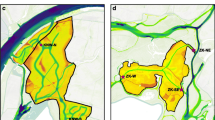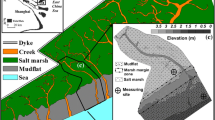Abstract
Based on surveyed data from seven coastal sections and the collected data of wind, sea level, tide, nearshore suspended sediment concentration and river flux from adjacent stations, this paper deals with regressive correlation between monthly average flat elevation and monthly average figures of the influential factors. All sections except one which is located within the river mouth showed negative correlation between flat elevation and sea level and between flat elevation and tidal range, with correlation coefficients being −0.53 – −0.91 (−0.77 on the average) in the former condition and −0.56 – −0.97 (−0.80 on the average) under the latter. Each of the sections with available suspended sediment concentration (SSC) data shows a positive correlation between flat elevation and SSC, with correlative coefficients being 0.35 – 0.97 (0.66 on the average). Only two sections (one in the Changjiang River Estuary and the other in the Hangzhou Bay) which are similar to beaches in sediment grain-size and slope gradient showed a negative correlation between flat elevation and onshore wind frequency and between flat elevation and average wind velocity, with correlative coefficients being respectively −0.57 and −0.69 (−0.63 on the average) in the former situation and −0.61 and −0.75 (−0.68 on the average) in the latter. Other sections did not show uniform relationship between flat elevation and wind conditions. Due to local marine factors the nearshore SSC in the studied area is negatively correlated with the Changjiang River sediment flux (r=−0.78), which results in false negative correlation between flat elevation and river sediment flux. The paper also gives sediment dynamic and morphodynamic explanation for the above correlations. Sea level rise results in the spread of breaker zone from subtidal area to intertidal area and then increases the intertidal water energy. The larger the tidal range, the stronger the tide currents and the easier for the flat to be eroded. The higher the SSC of flood water, the easier for the sediment to deposit down. Because of correlations among the influential factors, it is difficult to give the prime one which dominates the erosion and accretion processes in tidal flats.
Similar content being viewed by others
References
Anderson F. E., 1983. The northern muddy intertidal: seasonal factors controlling erosion and deposition—A Review. Can. J. Fish. Aquat. Sci. 40(Suppl. 1): 143–159.
Bruun P., 1962. Sea-level rise as a cause of shore erosion. Journal Waterways and Harbours Division, (88): 117–130.
Chen Weiyue, 1991. Sediment transportation and dynamic environment in tidal flats—take the northern coast of the Hangzhou Bay and the southern coast of the Changjiang Estuary as examples. Acta Oceanalogica Sinica, 13(6): 813–821. (in Chinese)
Ji Zixiu, Jiang Zhizhuan, Zhu Jiwen et al., 1993. Possible impacts of sea level rise on coastal erosion in the Changjiang Delta and the coastal plain of northern Jiangsu. Acta Geographica Sinica, 48(6): 516–526. (in Chinese)
King C. A. M., 1953. The relationship between wave incidence, wind direction and beach changes at Marshden Bay, Co. Durham. Trans. Inst., Brit. Geog., 19:13–23.
Komar P. D., 1976. Beach Processes and Sedimentation. New York: Prentice-Hall Inc, 429.
Lafon E. C., 1939. Sand movement near the beach in relation to tides and waves. Proc. 6th Pac. Sci. Cong., 795–799.
Li Yan, Zhang Liren, Xie Qingchun, 1987. Cycles of tidal flats in Damutu, Xiangshan, Zhejiang Province. Acta Oceanologica Sinica, (6): 725–734. (in Chinese)
Shepard F. P., 1950. Beach cycles in Southern California. U. S. Army Corps of Engrs, Beach Erosion Board Tech Memo, (20):26.
Wang Baocan, Huang Yangsong, 1989. Coastal Dynamic Geomorphology. Shanghai: East China Normal University Press. 31. (in Chinese)
Yang Shilun. 1991. Effect of wind-driven waves on short term changes in eastern Nanhui tidal flat—a case study for open muddy coasts. Marine Science, (2):59–63. (in Chinese)
Yang Shilun, Chen Jiyu, 1994. On the role of vegetation in the physical processes of tidal flats. Oceanologia et Limnologia Sinica, 25(6): 631–635. (in Chinese)
Yun Caixing, 1983. Erosion and accretion of tidal flats and sediment exchange between shore and channel in the Changjiang Estuary. Journal of Sedimentation Research, (4):235–244. (in Chinese)
Zhang Keqi, Jing Qinxiang, Wang Baocan, 1994. A spectrum analysis of dynamic system of the tidal flat at Zhangjiaku, the northern coast of the Hangzhou Bay. Oceanologia et Limnologia Sinica, 25(4): 446–451. (in Chinese)
Author information
Authors and Affiliations
Rights and permissions
About this article
Cite this article
Yang, S., Chen, X. & Zhang, Z. Factorial analysis of annual erosion-accretion cycles of tidal flats in the front area of the southern Changjiang river delta. Chin. Geograph.Sc. 8, 1–11 (1998). https://doi.org/10.1007/s11769-997-0077-y
Received:
Issue Date:
DOI: https://doi.org/10.1007/s11769-997-0077-y




